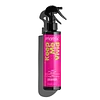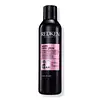What's inside
What's inside
 Key Ingredients
Key Ingredients

 Benefits
Benefits

 Concerns
Concerns

 Ingredients Side-by-side
Ingredients Side-by-side

Water
Skin ConditioningPropylene Glycol
HumectantHydrogen Peroxide
AntimicrobialOleyl Alcohol
EmollientPPG-2 Butyl Ether
Skin ConditioningLaureth-2
CleansingSodium C14-16 Olefin Sulfonate
CleansingPEG/PPG-4/12 Dimethicone
EmulsifyingCocamide Mipa
EmulsifyingAmodimethicone
Glycerin
HumectantPrunus Armeniaca Kernel Oil
MaskingParfum
MaskingDimethicone
EmollientCitric Acid
BufferingCarbomer
Emulsion StabilisingEthanolamine
BufferingLauryl Alcohol
EmollientPPG-5-Ceteth-10 Phosphate
EmulsifyingSodium Sulfite
PreservativeTaurine
BufferingCoco-Betaine
CleansingGuar Hydroxypropyltrimonium Chloride
Skin ConditioningMyristyl Alcohol
EmollientLimonene
PerfumingTrideceth-10
CleansingTrideceth-6
EmulsifyingTetrasodium Etidronate
Emulsion StabilisingSodium Chloride
MaskingTetrasodium Pyrophosphate
BufferingLinalool
PerfumingSodium Salicylate
PreservativeTetrasodium Glutamate Diacetate
Cetyl Alcohol
EmollientSodium Citrate
BufferingBenzyl Salicylate
PerfumingPEG-100 Stearate
Steareth-6
EmulsifyingCetrimonium Chloride
AntimicrobialBenzoic Acid
MaskingBenzyl Alcohol
PerfumingAlpha-Isomethyl Ionone
PerfumingTrideceth-3
EmulsifyingGlycine Soja Oil
EmollientArginine
MaskingSerine
MaskingTocopherol
AntioxidantGlutamic Acid
HumectantPhenoxyethanol
PreservativeTetrasodium EDTA
Acetic Acid
BufferingPentaerythrityl Tetra-Di-T-Butyl Hydroxyhydrocinnamate
AntioxidantWater, Propylene Glycol, Hydrogen Peroxide, Oleyl Alcohol, PPG-2 Butyl Ether, Laureth-2, Sodium C14-16 Olefin Sulfonate, PEG/PPG-4/12 Dimethicone, Cocamide Mipa, Amodimethicone, Glycerin, Prunus Armeniaca Kernel Oil, Parfum, Dimethicone, Citric Acid, Carbomer, Ethanolamine, Lauryl Alcohol, PPG-5-Ceteth-10 Phosphate, Sodium Sulfite, Taurine, Coco-Betaine, Guar Hydroxypropyltrimonium Chloride, Myristyl Alcohol, Limonene, Trideceth-10, Trideceth-6, Tetrasodium Etidronate, Sodium Chloride, Tetrasodium Pyrophosphate, Linalool, Sodium Salicylate, Tetrasodium Glutamate Diacetate, Cetyl Alcohol, Sodium Citrate, Benzyl Salicylate, PEG-100 Stearate, Steareth-6, Cetrimonium Chloride, Benzoic Acid, Benzyl Alcohol, Alpha-Isomethyl Ionone, Trideceth-3, Glycine Soja Oil, Arginine, Serine, Tocopherol, Glutamic Acid, Phenoxyethanol, Tetrasodium EDTA, Acetic Acid, Pentaerythrityl Tetra-Di-T-Butyl Hydroxyhydrocinnamate
Alternatives
Ingredients Explained
These ingredients are found in both products.
Ingredients higher up in an ingredient list are typically present in a larger amount.
Benzyl Alcohol is most commonly used as a preservative. It also has a subtle, sweet smell. Small amounts of Benzyl Alcohol is not irritating and safe to use in skincare products. Most Benzyl Alcohol is derived from fruits such as apricots.
Benzyl Alcohol has both antibacterial and antioxidant properties. These properties help lengthen the shelf life of products. Benzyl Alcohol is a solvent and helps dissolve other ingredients. It can also improve the texture and spreadability.
Alcohol comes in many different forms. Different types of alcohol will have different effects on skin. This ingredient is an astringent alcohol.
Using high concentrations of these alcohols are drying on the skin. They may strip away your skin's natural oils and even damage your skin barrier. Astringent alcohols may also irritate skin.
Other types of astringent alcohols include:
According to the National Rosacea Society based in the US, you should be mindful of products with these alcohols in the top half of ingredients.
Any type of sanitizing product will have high amounts of alcohol to help kill bacteria and viruses.
Learn more about Benzyl AlcoholBenzyl Salicylate is a solvent and fragrance additive. It is an ester of benzyl alcohol and salicylic acid. This ingredient can be naturally found in some plants and plant extracts.
In fragrances, Benzyl Salicylate may be a solvent or a fragrance component. In synthetic musk scents, it is used as a solvent. For floral fragrances such as lilac and jasmine, it is used as a fragrance component. The natural scent of Benzyl Salicylate is described as "lightly-sweet, slightly balsamic".
While Benzyl Salicylate has been associated with contact dermatitis and allergies, emerging studies show it may not be caused by this ingredient alone.
However, this ingredient is often used with fragrances and other components that may cause allergies. It is still listed as a known allergen in the EU. We recommend speaking with a professional if you have concerns.
Another study from 2021 shows Benzyl Salicylate may have anti-inflammatory properties.
Learn more about Benzyl SalicylateGlycine Soja Oil comes from the soybean. Glycine Soja is native to eastern Asia.
Soybean oil is an emollient. It is rich in antioxidants and fatty acids including palmitic, stearic, oleic, and linoleic acids.
As an emollient, the fatty acids in soybean oil helps keep your skin soft and hydrated. It does so by creating a film on top that traps moisture in.
Soybean oil is also rich in vitamin E, a potent antioxidant. Vitamin E is also anti-inflammatory and provides a soothing effect.
Studies show soy may help fade hyperpigmentation from UVB. It does so by disrupting the melanin process from UVB induced skin inflammation.
This ingredient may not be malassezia folliculitis, or fungal-acne, safe.
Soybeans are rich in proteins and are part of the legume family. Foods made with soybeans include tofu, soymilk, edamame, miso, and soy sauce.
Learn more about Glycine Soja OilParfum is a catch-all term for an ingredient or more that is used to give a scent to products.
Also called "fragrance", this ingredient can be a blend of hundreds of chemicals or plant oils. This means every product with "fragrance" or "parfum" in the ingredients list is a different mixture.
For instance, Habanolide is a proprietary trade name for a specific aroma chemical. When used as a fragrance ingredient in cosmetics, most aroma chemicals fall under the broad labeling category of “FRAGRANCE” or “PARFUM” according to EU and US regulations.
The term 'parfum' or 'fragrance' is not regulated in many countries. In many cases, it is up to the brand to define this term.
For instance, many brands choose to label themselves as "fragrance-free" because they are not using synthetic fragrances. However, their products may still contain ingredients such as essential oils that are considered a fragrance by INCI standards.
One example is Calendula flower extract. Calendula is an essential oil that still imparts a scent or 'fragrance'.
Depending on the blend, the ingredients in the mixture can cause allergies and sensitivities on the skin. Some ingredients that are known EU allergens include linalool and citronellol.
Parfum can also be used to mask or cover an unpleasant scent.
The bottom line is: not all fragrances/parfum/ingredients are created equally. If you are worried about fragrances, we recommend taking a closer look at an ingredient. And of course, we always recommend speaking with a professional.
Learn more about ParfumTocopherol (also known as Vitamin E) is a common antioxidant used to help protect the skin from free-radicals and strengthen the skin barrier. It's also fat soluble - this means our skin is great at absorbing it.
Vitamin E also helps keep your natural skin lipids healthy. Your lipid skin barrier naturally consists of lipids, ceramides, and fatty acids. Vitamin E offers extra protection for your skin’s lipid barrier, keeping your skin healthy and nourished.
Another benefit is a bit of UV protection. Vitamin E helps reduce the damage caused by UVB rays. (It should not replace your sunscreen). Combining it with Vitamin C can decrease sunburned cells and hyperpigmentation after UV exposure.
You might have noticed Vitamin E + C often paired together. This is because it is great at stabilizing Vitamin C. Using the two together helps increase the effectiveness of both ingredients.
There are often claims that Vitamin E can reduce/prevent scarring, but these claims haven't been confirmed by scientific research.
Learn more about TocopherolWater. It's the most common cosmetic ingredient of all. You'll usually see it at the top of ingredient lists, meaning that it makes up the largest part of the product.
So why is it so popular? Water most often acts as a solvent - this means that it helps dissolve other ingredients into the formulation.
You'll also recognize water as that liquid we all need to stay alive. If you see this, drink a glass of water. Stay hydrated!
Learn more about Water